II.
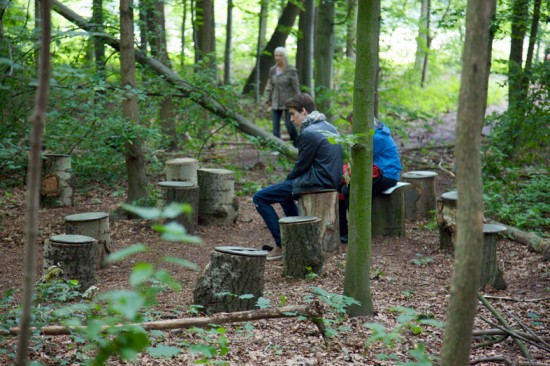
Janet Cardiff & George Bures Miller – Forest (for a thousand years) (2012), audio installation in forest, 28 min audio loop. Installation view at dOCUMENTA (13), Kassel. All images: © Jane Cardiff & George Bures Miller, courtesy Gallery Koyanagi, Tokyo.
ART iT: You mentioned the idea of Hollywood-style video walk productions. Compared to movies, or even to more conventional art works, with your walk and video pieces it must be a real luxury to make works that can only be experienced in a specific place, and can’t really travel.
JC: Yes, and even for the new walk we’re working on, we’re talking about making it downloadable, but only during the specific time period between 5 and 10pm, and only within a specific area.
GBM: But we’re also fortunate that we can control every aspect of our works. A filmmaker makes a piece, but then it goes into the cinema and maybe one speaker isn’t working or the surround system isn’t working. We’re always in control of that. With Murder of Crows we had the luxury of this giant matrix of speakers that we could compose for. So we don’t have the audience a filmmaker has, but we don’t need that. We’re not making huge budget works that we need to sell to mega amounts of people. And the audience in the art world is accepting of and interested in things that are weird and different and don’t have storylines. We grab the Hollywood tropes, throw them in, and then people have to make up their minds on what the story’s about. We want to make the audience work. The problem with film now is they want to give the audience everything, tell you everything.
JC: With the Alter Bahnhof Walk, at the very end there’s a five-minute sequence with these two dancers. We wanted a metaphor for relationships, so the dancers choreographed a piece for us. The whole walk has certain things that come out about the history of the site and about your relationship to my voice, and then at the end there’s this bit about relationships that’s expressed through dance, which is another language. Our idea is that things go together in your mind like poetry. You piece it together and get some feeling at the end. There’s a certain poetic combination that we’re interested in.
GBM: We’re always being asked to explain our work, and we put the dance in at the end to show that you can’t always explain everything through words. There were no words in the piece after that. We didn’t try to explain it. Some people didn’t really like the dance at the end, and some thought it was amazing.
JC: That always happens. It’s like after The Forty Part Motet (2001), which has been a very successful piece, people started suggesting to us, Why don’t you do Mozart’s “Requiem”? But you could go on forever doing classical pieces. The music we used became Forty Part Motet because it is a 40-part harmony. It makes sense to break it apart into 40 different speakers to show the complexity of the composition. Then we came back to that way of working with Murder of Crows because we wanted to see if we could combine the way the audio works in the audio walks with the way it worked in Forty Part Motet, and create the idea of a journey through sound where the sound moves around you.
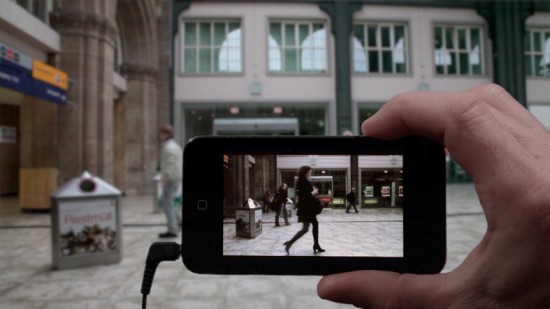
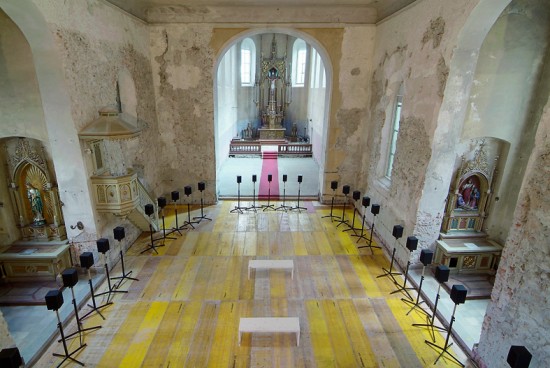
Top: Janet Cardiff & George Bures Miller – Alter Bahnhof Video Walk (2012), video walk, 26 min. Produced for dOCUMENTA (13), Kassel. Still frame from representational video of the walk. Bottom: Janet Cardiff – The Forty Part Motet (2001), a re-working of “Spem in Alium Nunquam Habui 1573,” by Thomas Tallis; 40 loud speakers mounted on stands, placed in an oval, amplifiers, playback computer, 14 min loop with 11 min music and 3 min intermission. Installation view at Johanniterkirche, Feldkirch, Austria. Photo Markus Tretter.
ART iT: This was achieved with your use of ambisonic recording, right?
GBM: Exactly. It’s old-tech/hi-tech, from the 1970s, which is cool. We love to find these old technologies that weren’t commercially successful. There were over 700 tracks or channels in Murder of Crows, which was insane. When you start moving sounds, if you pan even a mono sound over 24 tracks – say a crow flying – you need all those 24 tracks for that one mono sound. Then if you start panning a bunch of mono “crows” and have two of them going across 48 speakers, you’re dealing with 96 tracks for only two sounds. So with Murder of Crows the track count was enormous. My tonmeister and I were not sure we could get through it. For playback we had to mix all the tracks so that it’s actually playing 98 channels. That was fine for the computer, but it was the final mix of trying to get all this stuff down to the 98 channels that was the real challenge. Generally a musician will start with 100 channels and mix that into two channels for playback, whereas we had 700 channels that we were mixing down to 98. It was a nightmare.
ART iT: One of the interesting things about the walks is how they incorporate the multiple registers of voice and speech – commands, observations, narrative – along with ambient sounds like footsteps or breathing, and environmental sounds like birds, as well as the sounds of the real world filtering through the recording. I see a connection between this and the process of mixing the soundtrack for Murder of Crows.
JC: Yes. It’s about all those different levels of understanding. We’re always aware of the different levels of the voice, how it can be more commanding if used one way and more observational if used another way.
GBM: We also like how the different sounds overlap and create another reality. The mixture of the two realities – the physical sounds and the virtual tracks – create a third reality. Then with the video walks you have so much going on, too. Even with Paradise Institute, we were trying to push it a little further beyond just being a theatre with other people around you; at some points we tried to make it feel like there were people physically banging on the outside of the box. And sometimes we just cut the image and used only sound, because visuals are so powerful, we often find that you have to get rid of them completely for people to realize what they’re hearing is just a fabrication.
JC: We were interested in where people’s minds go when they watch movies. There might be a scene in the movie that reminds you of something, so then you’re lost in your mind, kind of like when you’re driving, thinking of something else and you don’t even realize you’re driving until afterwards. We wanted to do a three-dimensional version of how people see movies – someone even called it “cubist cinema,” which is a nice understanding. You’re physically here, but you’re also in the movie, and then the movie comes in and mixes with your thoughts about, “Oh, did I leave the stove on?”
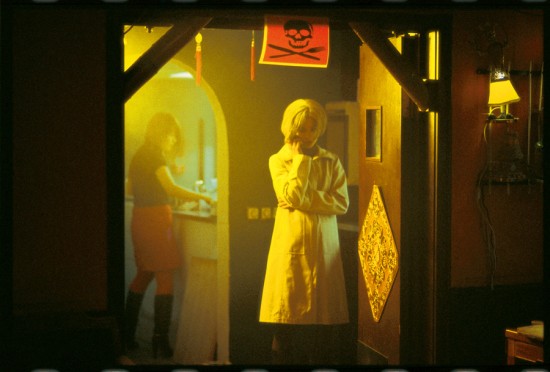
Janet Cardiff & George Bures Miller – Berlin Files (2003), wooden panels, video loop with 12-channel surround sound audio, 9 m x 7.5 m x 3.5 m; 13 min. Film still.
ART iT: My impression is that when you’re recording sounds for the walks, what you’re doing is quite similar to the foley recordings in cinema.
GBM: Except it’s different in that they create their sounds. We really like real stuff, although we’ve done a bit of foley as well. In cinema, any footstep you hear is never real. If it’s the sound of high heels, then there’s a guy in high heels walking across the sound stage, and if it’s a kiss, it’s an old guy with a beard smooching himself, or they use lettuce and celery for breaking bones. Any sound you hear in cinema is a fiction. The only thing you hear that was recorded with the image is the voice.
JC: But I think also what you’re talking about is that they are like film soundtracks for the real world. They are constructed like film soundtracks.
GBM: But we really try to use real sounds, even when shooting film. The film Berlin Files (2003) was also made using ambisonic recording. In the end we couldn’t record the sound and video together, but we really tried to do the sound recording in the same spaces where we were filming. Visually, there were a lot of tracking shots through cool Berlin landscapes and bars, so we reproduced the tracking shots with the sound as well. We wanted it to feel like there was a sphere of sound moving around you as you watched the film.
And we spent an incredible amount of time on Murder of Crows, as well as the documenta piece, Forest, which actually comes out of Crows. So Forty Part Motet, Crows and Forest are all related, which ties nicely into the walks because you’re in a forest and you hear the recorded birds, but you also see real birds around you, or a plane goes by in the soundtrack, and you can’t tell whether it’s a real plane or not. We spend a lot of time standing outside with a microphone, actually.
ART iT: What is your approach in a work like Experiment in #F Minor (2013), with the fragments of music played back through speakers that respond to automated sensors?
JC: We finished it right before the survey show which opened in April at Art Gallery of Ontario in Toronto, and we probably could have used a couple more weeks on the piece. But sometimes it’s good that you have to throw it out because you could play with it for another month. With this piece we liked the concept that you could have an unlimited possibility for a piece of music according to where you are positioned, because if someone’s standing in front of one sensor, they’re activating and hearing one six-second part of it. The whole composition is a two-and-a-half-minute song that loops, so as you move around the table you hear different parts, but you might not hear the end of the part beforehand, so you construct the music through your movement. That was the conceptual basis for us, and now we realize it’s unlimited what you could do. You could do film soundtracks with footsteps and all sorts of things, or you could do a whole orchestra.
GBM: We’re going to make another one perhaps.
JC: You could have bigger speakers inside the table to create more base. You could move the sensors apart so you don’t have quite the mixture of sound that this one has. It gets pretty intense. At the opening at Gallery Koyanagi it was constantly loud. I also like how people start waving their hands over the table, while others stand back and watch these “performers,” so the audience becomes the performer.
ART iT: If you don’t know where the sensors are, it seems natural to explore the piece through movement, to see whether you can control the intensity by waving your arms in one direction or another. The work sucks you into performative behavior. With the walks too, there’s a mechanism of unconsciously entering a different zone of behavior.
JC: You see how unlimited it could be. It’s like an instrument.
GBM: That’s the problem for us. We’re always discovering these things that could be unlimited.
JC: With Pandemonium (2005), for which we installed robotic percussive beaters in the cells of the Eastern State Penitentiary Museum in Philadelphia, we discovered that was like an instrument too. You could have made any piece of music with it. You could invite percussionists in and say, here’s an instrument, what do you want to do with it? There’s all these offshoots that would be great to follow through. Our problem is we have too many ideas and not enough time.
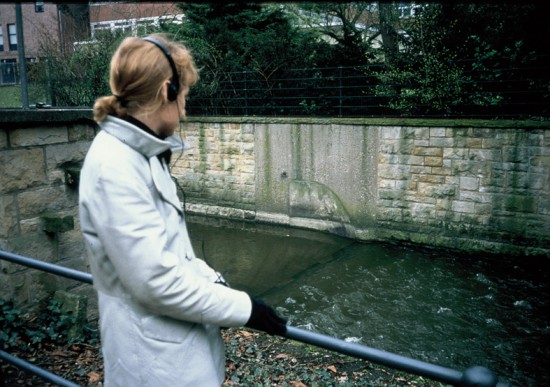
Janet Cardiff – Münster Walk (1997), audio walk with mixed-media props, 17 min. Curated by Kasper König (with assistant curator Ulrike Groos) for Skulptur. Projekte in Münster, 1997.
ART iT: That piece was one reason why I feel your works are about haunting. It’s like you reanimate the spirits of the prisoners. These sites of conflict or resistance are always the most haunted. Well, I wouldn’t say that actually. Most places are equally haunted in some way or another.
GBM: But you’re right, some sites have more resonance. We like to work with sites that have resonance. We get asked to do walks everywhere, and it’s ok, but there are really few occasions that are super interesting. The train station in Kassel was amazingly resonant because of the history in Germany. We actually took you to the platform where the Jews were loaded onto the trains going to the concentration camps, so you were standing right at that spot, and then you would see a nice new train head off into the distance.
JC: Behind this idea of ghostliness is that we all have a fascination, when we walk somewhere, of imagining who’s walked there before, especially in a historical place. We can never grasp it. Sometimes the audio walks are very much about that. Münster was inspired by a former student of mine who had lost her son in a car accident. He was an artist, and had his camera equipment in the back of the car, so she took the photos that he had done, and his camera equipment, and went to the same locations and tried to look through the lens to get him back, or at least synchronize herself with him. And the Münster walk was very much about trying to synchronize yourself with the footsteps of someone who had died. You were seeing what they saw from the same viewpoint, and thinking about how that connects you. That is such a nice poetic thing I think.
Pt I
Janet Cardiff & George Bures Miller: The Rings of Saturn
